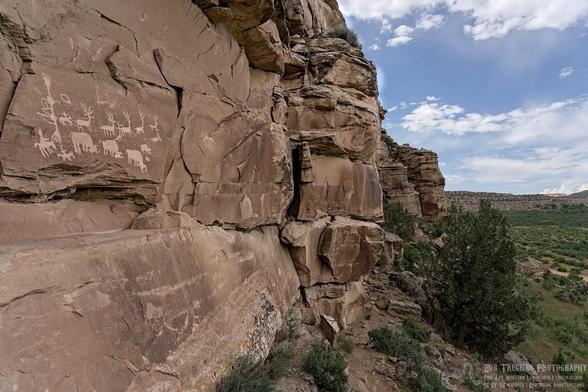Recent searches
Search options
A nice, likely, post-contact petroglyph panel. (Note the possible persons on horseback.) I brought up the contrast using drawn and parametric masks in Darktable to better highlight the glyph elements.
@elaterite
How do you like Darktable? I come from a Photoshop background, and I’ve used Lightroom on Mac for ages, but my brother uses Gimp on Linux. Dunno if he’s tried Darktable.
@tryonk Darktable is the only RAW developer I've used being a Linux only since the '90s. I've only used Photoshop at work just to print my Darktable exported tiffs on our large format printers. I think Darktable is superior to Adobe both technically & philosophically. Its color science is (was) cutting edge, although that developer left the project awhile ago & philosophically with no subscription, no phony sky replacement, & no AI digital art garbage. An honest app for honest photography. 1/2
@tryonk And I might add that Adobe really pisses me off when I saw them run advertisements stating something along the lines of: Skip the photo shoot, use our AI.
I mean, what a slap in the face to their customers. Customers they buffaloed into subscribing to their software for the last decade or so. There are options... 2/2
@elaterite
I teach Photoshop and I must say it's a lot less fun. Clients expect PS to come up with anything. The same is slowly happening in Illustrator: you can prompt to feed Adobe's AI ( heh, an Illustrator file has the extension .ai) after which said Ai renders vectors. Maybe one day Ai 'art' will be the cheap norm and human art will be highly saught after. At least, that's what I dream about. The worst are supervisors who are clueless on good design and just let the minions rip.
@tryonk
@pascaline @elaterite I do IT now, but I worked in advertising for 10ish years as a production artist and general geek in the shop (I kept the printers clean and the hardware running). Bad customers make bad design. Good artists have to teach their customers to appreciate good design. We did ridiculous amounts of client manipulation to steer them toward better design without going further than their brains could handle. ;-)
Trying Darktable on my Macbook Pro, and it's definitely for color science geeks. I learned color calibrating monitors and printers and understand color spaces and gamut, but it's going to take a deep dive to learn what the film emulation parameters do. First image I tried was Christmas tree lights to see if I could make something so essentially colorful look good in B&W. Interesting results. Very tweakable. Color mix has an obvious effect.
Bob, curious where elaterite comes from. My sister lived in Liberia for 15 or 20 years, and many of the roads there are made by clearing the vegetation and rolling the underlying red laterite clay. Very distinctive color. Gets into everything. It also turns to mush in the rain—you can spot the southern and northern expats by whose cars are off the side of the road (wet clay is a lot like wet snow).
@tryonk @pascaline Lol--ya, elaterite is nasty stuff. Kind of like asphalt. I chose it for a handle when I first got online in the '90s. But for me it references Elaterite Butte near the Maze Overlook in Southeastern Utah. I never walked over to the actual butte itself, I need to do that sometime, but it is composed of sandstone, not elaterite. However, maybe there's some exposed elaterite there? There are a lot of fossil fuel deposits in that area, sadly. https://en.wikipedia.org/wiki/Elaterite_Butte
Cool. I’m a northeastern boy, and the Adirondacks are my happy place. I’ve been to Colorado, SoCal, and Oregon (my wife was born outside LA, and her brother lives near Portland). Different kind of beauty. Hiked Havasu Canyon 30 years ago—nothing like it here.
@tryonk @pascaline Cool! Welcome abroad! :) For B&W I use the 'Color Calibration' module > Gray tab > check 'normalize channels' > & move the 'input R' to +0.010. That gives me my basic grayscale. I make sure 'color balance rgb' is neutral (no preset) & I add (often) 20% contrast. I use a standard 125 preset in the 'local contrast' module. Then I adjust the 'exposure.' I'll go back to the 'color balance rgb' & use the brilliance grading at the bottom 'highlights' to recover any that are blown.
I have a pretty well developed Lightroom process, and I was looking for the matching tools in Darktable. They must be there—I just need to adjust to the Zen of DT vs the Zen of LR. Thanks for the B&W tips—I’d figured out the basics of the calibration module, but I’m not very experienced with B&W in general. Online manuals and forums help.
I also like to add an extra channel to enhance the blacks, for instance, but I use Photoshop for that. It can deepen the image while preventing dark areas to bleed into one another into one big lump of nothing.
But you know, even (self professed?) professionals can mess up with B&W. A hired photographer who was doing my portrait for work really sucked at photo editing. There was no difference between my hair and a black monitor in the back: one black area without details
@elaterite
Yup—it's always a trick to balance strong blacks with shadow detail. Sometimes I think I hold back because I'm trying too hard to maintain detail—I'd rather have a little black clipping than white clipping because that's really obvious.
@tryonk @pascaline I feel that any clipped highlights is unacceptable. I protect my highlights and let the shadows go wherever they go. If they clip I really don't care. There are exceptions to all of that, but they are very rare, like shooting sunsets, which I almost never do these days unless the sun is behind something.
@elaterite It was a revelation when I learned to use the Highlights control in Lightroom. So long as my whites aren't completely blasted out, I can retrieve some detail from almost anything. If I'm working in a program that supports layers, you can repair blowouts by copying a feathered section of image and placing it over the hole in a mostly transparent multiply or darken layer. I rarely get that deep into retouching now, but I can do it when I need to.
@tryonk @pascaline These two channels may help get you started. I think https://www.youtube.com/@audio2u/videos made a couple of videos for people moving from Lightroom to Darktable, but if not, he still has a nice series to help new people get started. And this guy's channel is good too: https://www.youtube.com/@s7habo/videos If you want a deep dive into the color science, the guy who wrote most of it in DT has a channel where he really digs down on the topic. Let me know if you want the link. I'll have to find it again.
Oh, I so agree on teaching the clients! I once printed something they said was good enough next to the quality I was after. Only then they saw the difference.
And there are bad bosses. My former boss told me to use a tiny 'Smurf' GIF he downloaded (2.5 cm /~ 1 inch) and print it on a poster. I said it was too small for that print size. He didn't believe it. I didn't want to let the client down and took the file home to trace it in Illustrator For free, of course. Pride.
Oh, lordy, do I feel that. Thankfully the agency I worked for was run by art directors, not salespeople, and I never had to do that. Clients, on the other hand, have wanted me to create butt-ugly stuff. I’ve been out of design as a day job for almost 25 years now, but those experiences leave a mark.
Working for real art directors is great: you get to do creative work and learn even more! Having the required skill set to get started is crucial though. And I have had quite a few clients who wanted to learn graphic design in three days max I refuse such clients. One wanted to get a job to learn it and create designs even before learning how to use the software. They had lofty dreams about walking around on the work floor while people there were teaching them
And
I learned video editing between jobs working for free for a friend of a friend (I was just waiting for my start date), who hired me a year later. We used Photoshop as a video paintbox (early 90s), which let me learn enough to land a job at a design studio a year later, when the first agency lost some large clients and had to lay me off. I’ve never been afraid of manuals, and learned by doing. Our art directors told me what they wanted, and I figured out how to get that.
@elaterite @tryonk If it weren't for the 600GB or so I've got in my library, I'd think about switching. Adobe products work pretty well, and I used them as professional tools for a long time. However, renaming Lightroom to Lightroom Classic and removing pro-friendly features from Lightroom CC gives me the heebie-jeebies. I insist on keeping all my originals on my local drive and making my own backups, so switching is an option. It will just involve a ton of work.
@tryonk It sounds like you know computing well & I agree, Adobe products do work, it's the proprietary nature of their software & the philosophy of the company I don't agree with. The Free Libre Open Source community (FLOSS or FOSS), is for me, a way of life. I donate to the projects whose software I use &, in case you didn't notice, my photography carries a Free Culture Creative Commons license. Like the inimitable @nina Paley says, "Copyright is brain damage." https://blog.ninapaley.com/2015/10/22/copyright-is-brain-damage/ 1/n
@tryonk Regarding storage: I have two 1TB internal hard drives and a third 2TB hard drive. For back up I have four matching 1tb external drives and two 2TB external drives. One set of drives is stored locally and one set off site. I've got a ways to go to fill up the remaining storage on the 2TB drive. But when I do, I'll just get another set of drives. No cloud storage here to *worry* about. And, of course, I wouldn't want to pay for it anyway. I'll control my data thank you very much! 2/2
Cool. Getting petroglyphs to be visible is tricky.


